A Literature Review on Cyber Data Theft in UK and Consumer Confidence
VerifiedAdded on 2021/05/31
|41
|7140
|19
Literature Review
AI Summary
This literature review examines the pervasive issue of cyber data theft within the UK, particularly focusing on its implications for the retail industry and the subsequent impact on consumer confidence. The project delves into the theoretical frameworks, including consumer confidence theory and the theory of planned behavior, to understand consumer responses to data breaches. It analyzes various incidents, such as the WannaCry ransomware attack on the NHS and the Sony data breach, highlighting the vulnerabilities of both consumers and organizations. The review covers the evolution of cybercrime, the role of government in mitigating risks, and the importance of robust cybersecurity measures. Furthermore, it examines the legal and economic consequences of data theft, emphasizing the need for businesses to prioritize data protection to maintain consumer trust and ensure business continuity. The review draws on a variety of sources, including government reports, academic research, and industry analyses, to provide a comprehensive overview of the issue.
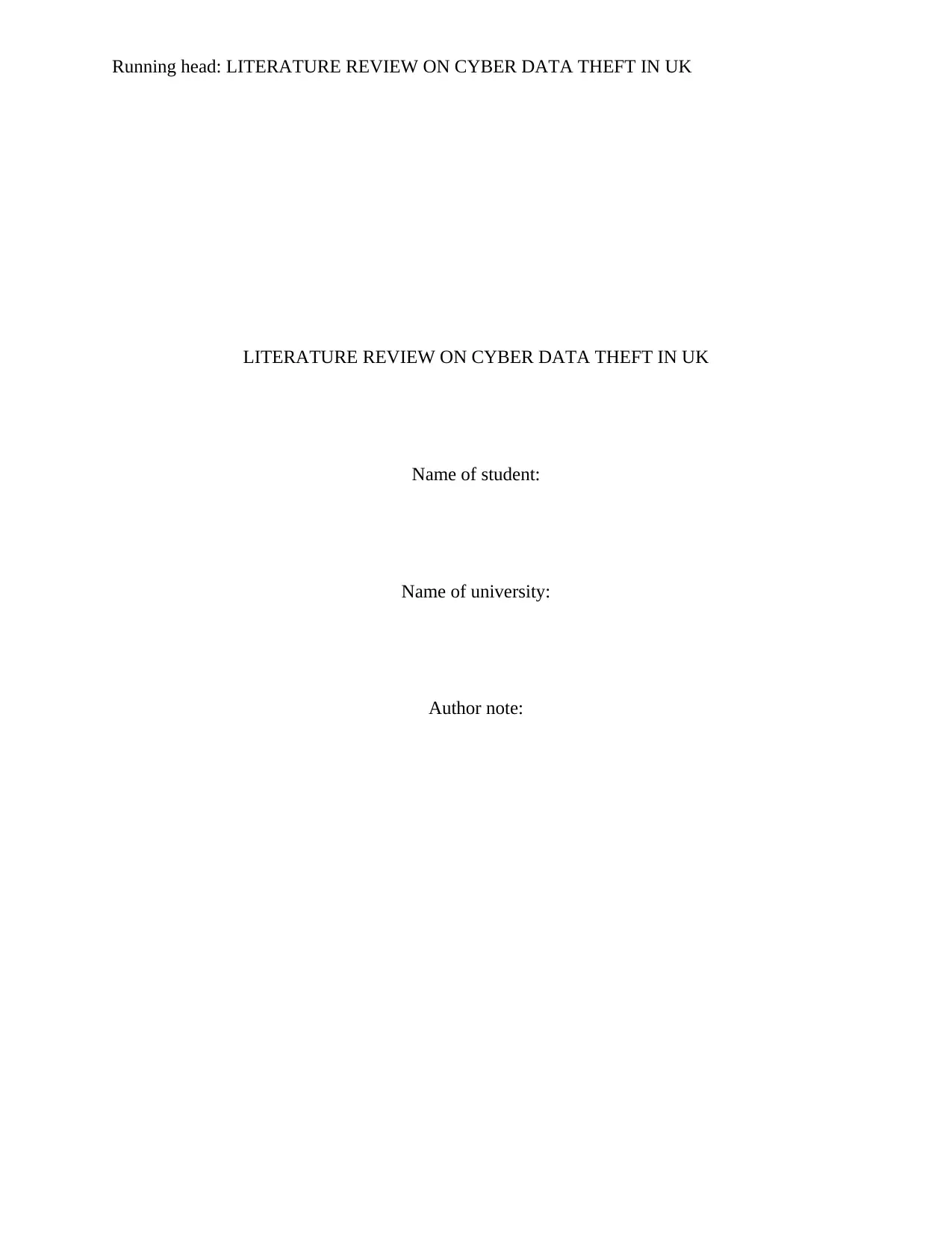
Running head: LITERATURE REVIEW ON CYBER DATA THEFT IN UK
LITERATURE REVIEW ON CYBER DATA THEFT IN UK
Name of student:
Name of university:
Author note:
LITERATURE REVIEW ON CYBER DATA THEFT IN UK
Name of student:
Name of university:
Author note:
Paraphrase This Document
Need a fresh take? Get an instant paraphrase of this document with our AI Paraphraser

1
CYBER DATA THEFT IN UK
Table of Contents
Introduction......................................................................................................................................3
Setting of the Project...................................................................................................................3
Aim of the project........................................................................................................................3
Reasons to choose the project......................................................................................................5
Literature Review............................................................................................................................6
Research Methodology:.................................................................................................................13
Research Outline........................................................................................................................13
Research Philosophy..................................................................................................................13
Research Approach....................................................................................................................14
Research strategy an Analysis Method......................................................................................14
Research design.........................................................................................................................15
Data collection...........................................................................................................................15
Sampling method.......................................................................................................................15
Ethical consideration.................................................................................................................15
Research limitation....................................................................................................................16
Primary Data..................................................................................................................................17
Analysis.....................................................................................................................................24
Linking The Studies...................................................................................................................26
CYBER DATA THEFT IN UK
Table of Contents
Introduction......................................................................................................................................3
Setting of the Project...................................................................................................................3
Aim of the project........................................................................................................................3
Reasons to choose the project......................................................................................................5
Literature Review............................................................................................................................6
Research Methodology:.................................................................................................................13
Research Outline........................................................................................................................13
Research Philosophy..................................................................................................................13
Research Approach....................................................................................................................14
Research strategy an Analysis Method......................................................................................14
Research design.........................................................................................................................15
Data collection...........................................................................................................................15
Sampling method.......................................................................................................................15
Ethical consideration.................................................................................................................15
Research limitation....................................................................................................................16
Primary Data..................................................................................................................................17
Analysis.....................................................................................................................................24
Linking The Studies...................................................................................................................26

2
CYBER DATA THEFT IN UK
Conclusion.....................................................................................................................................27
Appendix........................................................................................................................................34
CYBER DATA THEFT IN UK
Conclusion.....................................................................................................................................27
Appendix........................................................................................................................................34
⊘ This is a preview!⊘
Do you want full access?
Subscribe today to unlock all pages.

Trusted by 1+ million students worldwide
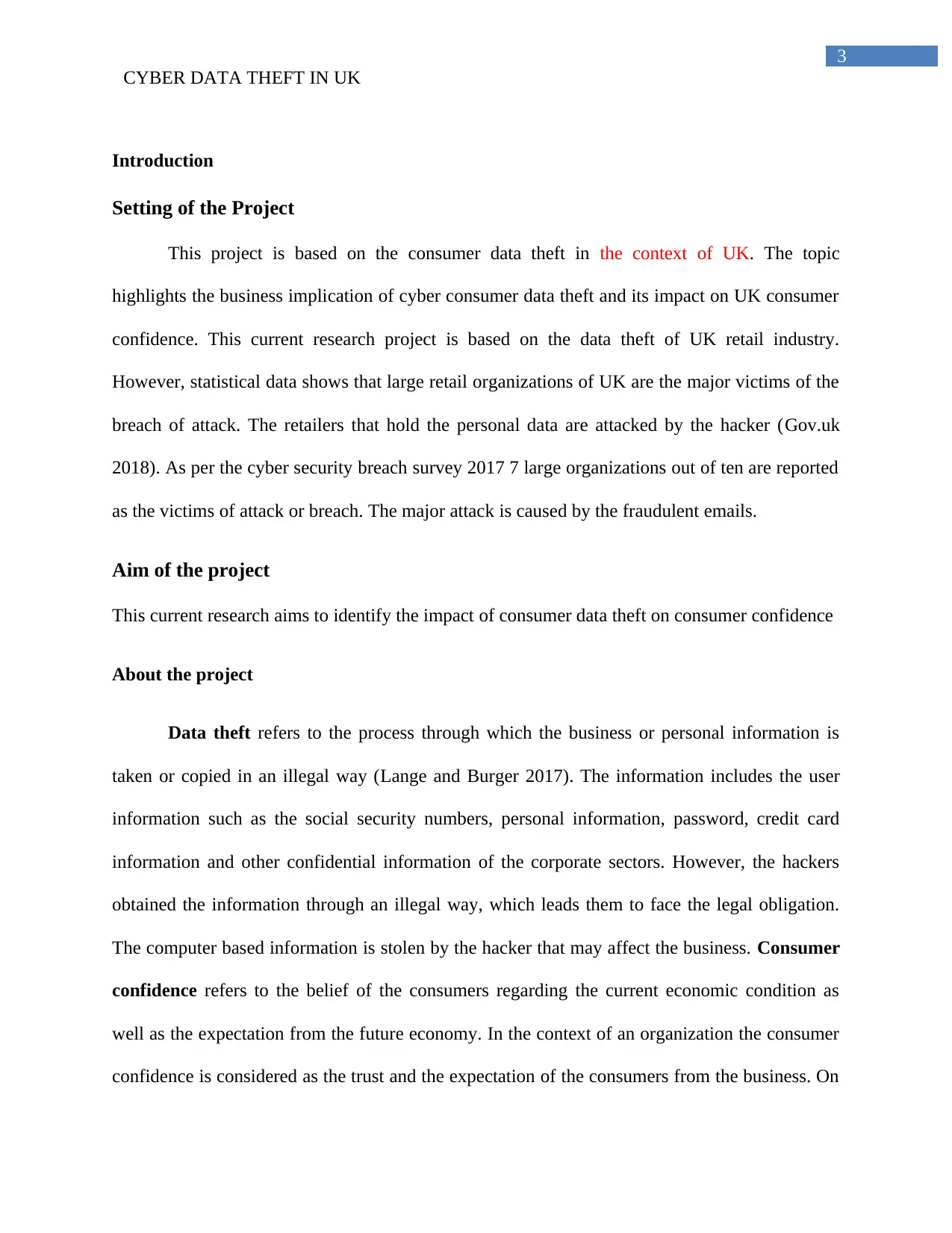
3
CYBER DATA THEFT IN UK
Introduction
Setting of the Project
This project is based on the consumer data theft in the context of UK. The topic
highlights the business implication of cyber consumer data theft and its impact on UK consumer
confidence. This current research project is based on the data theft of UK retail industry.
However, statistical data shows that large retail organizations of UK are the major victims of the
breach of attack. The retailers that hold the personal data are attacked by the hacker (Gov.uk
2018). As per the cyber security breach survey 2017 7 large organizations out of ten are reported
as the victims of attack or breach. The major attack is caused by the fraudulent emails.
Aim of the project
This current research aims to identify the impact of consumer data theft on consumer confidence
About the project
Data theft refers to the process through which the business or personal information is
taken or copied in an illegal way (Lange and Burger 2017). The information includes the user
information such as the social security numbers, personal information, password, credit card
information and other confidential information of the corporate sectors. However, the hackers
obtained the information through an illegal way, which leads them to face the legal obligation.
The computer based information is stolen by the hacker that may affect the business. Consumer
confidence refers to the belief of the consumers regarding the current economic condition as
well as the expectation from the future economy. In the context of an organization the consumer
confidence is considered as the trust and the expectation of the consumers from the business. On
CYBER DATA THEFT IN UK
Introduction
Setting of the Project
This project is based on the consumer data theft in the context of UK. The topic
highlights the business implication of cyber consumer data theft and its impact on UK consumer
confidence. This current research project is based on the data theft of UK retail industry.
However, statistical data shows that large retail organizations of UK are the major victims of the
breach of attack. The retailers that hold the personal data are attacked by the hacker (Gov.uk
2018). As per the cyber security breach survey 2017 7 large organizations out of ten are reported
as the victims of attack or breach. The major attack is caused by the fraudulent emails.
Aim of the project
This current research aims to identify the impact of consumer data theft on consumer confidence
About the project
Data theft refers to the process through which the business or personal information is
taken or copied in an illegal way (Lange and Burger 2017). The information includes the user
information such as the social security numbers, personal information, password, credit card
information and other confidential information of the corporate sectors. However, the hackers
obtained the information through an illegal way, which leads them to face the legal obligation.
The computer based information is stolen by the hacker that may affect the business. Consumer
confidence refers to the belief of the consumers regarding the current economic condition as
well as the expectation from the future economy. In the context of an organization the consumer
confidence is considered as the trust and the expectation of the consumers from the business. On
Paraphrase This Document
Need a fresh take? Get an instant paraphrase of this document with our AI Paraphraser
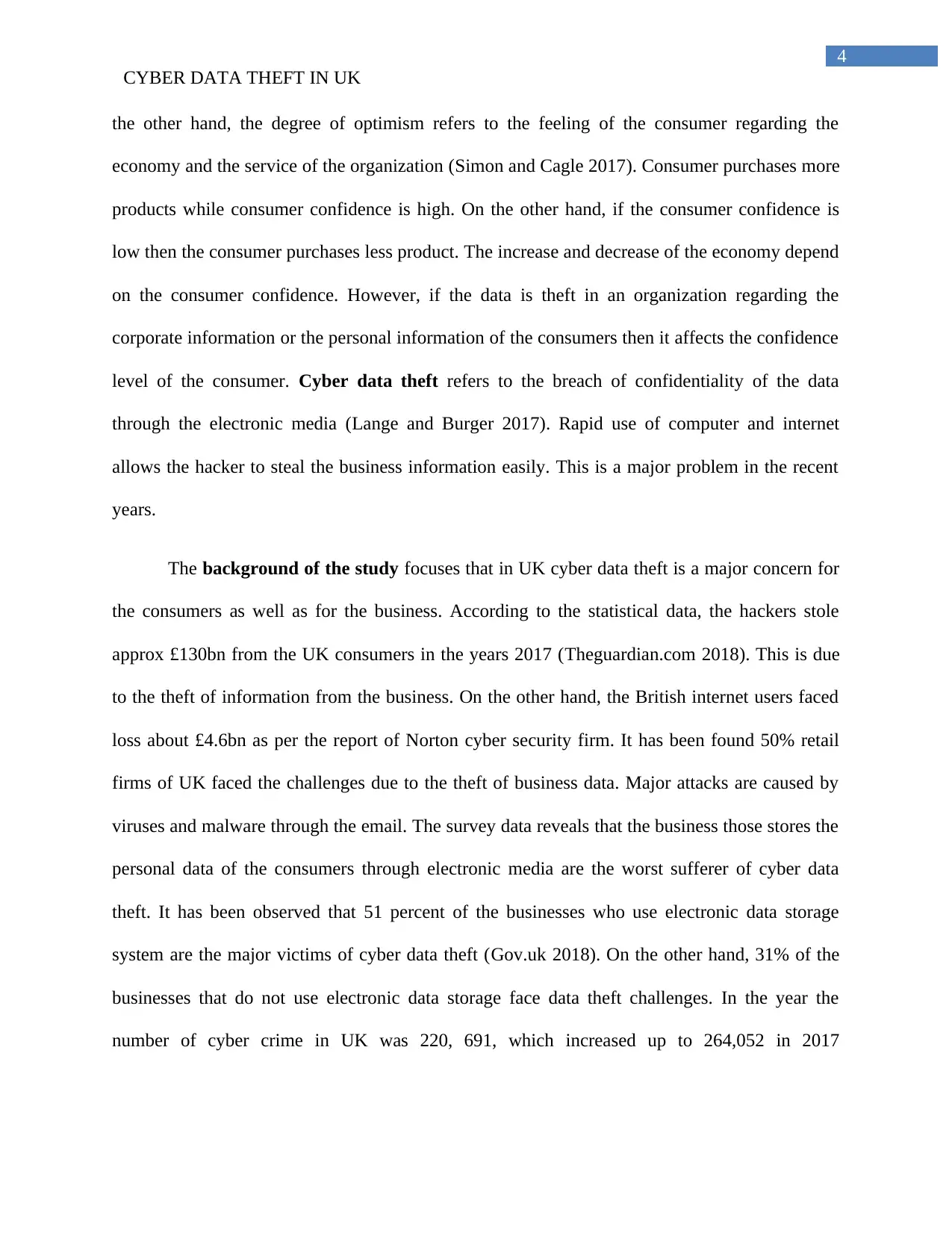
4
CYBER DATA THEFT IN UK
the other hand, the degree of optimism refers to the feeling of the consumer regarding the
economy and the service of the organization (Simon and Cagle 2017). Consumer purchases more
products while consumer confidence is high. On the other hand, if the consumer confidence is
low then the consumer purchases less product. The increase and decrease of the economy depend
on the consumer confidence. However, if the data is theft in an organization regarding the
corporate information or the personal information of the consumers then it affects the confidence
level of the consumer. Cyber data theft refers to the breach of confidentiality of the data
through the electronic media (Lange and Burger 2017). Rapid use of computer and internet
allows the hacker to steal the business information easily. This is a major problem in the recent
years.
The background of the study focuses that in UK cyber data theft is a major concern for
the consumers as well as for the business. According to the statistical data, the hackers stole
approx £130bn from the UK consumers in the years 2017 (Theguardian.com 2018). This is due
to the theft of information from the business. On the other hand, the British internet users faced
loss about £4.6bn as per the report of Norton cyber security firm. It has been found 50% retail
firms of UK faced the challenges due to the theft of business data. Major attacks are caused by
viruses and malware through the email. The survey data reveals that the business those stores the
personal data of the consumers through electronic media are the worst sufferer of cyber data
theft. It has been observed that 51 percent of the businesses who use electronic data storage
system are the major victims of cyber data theft (Gov.uk 2018). On the other hand, 31% of the
businesses that do not use electronic data storage face data theft challenges. In the year the
number of cyber crime in UK was 220, 691, which increased up to 264,052 in 2017
CYBER DATA THEFT IN UK
the other hand, the degree of optimism refers to the feeling of the consumer regarding the
economy and the service of the organization (Simon and Cagle 2017). Consumer purchases more
products while consumer confidence is high. On the other hand, if the consumer confidence is
low then the consumer purchases less product. The increase and decrease of the economy depend
on the consumer confidence. However, if the data is theft in an organization regarding the
corporate information or the personal information of the consumers then it affects the confidence
level of the consumer. Cyber data theft refers to the breach of confidentiality of the data
through the electronic media (Lange and Burger 2017). Rapid use of computer and internet
allows the hacker to steal the business information easily. This is a major problem in the recent
years.
The background of the study focuses that in UK cyber data theft is a major concern for
the consumers as well as for the business. According to the statistical data, the hackers stole
approx £130bn from the UK consumers in the years 2017 (Theguardian.com 2018). This is due
to the theft of information from the business. On the other hand, the British internet users faced
loss about £4.6bn as per the report of Norton cyber security firm. It has been found 50% retail
firms of UK faced the challenges due to the theft of business data. Major attacks are caused by
viruses and malware through the email. The survey data reveals that the business those stores the
personal data of the consumers through electronic media are the worst sufferer of cyber data
theft. It has been observed that 51 percent of the businesses who use electronic data storage
system are the major victims of cyber data theft (Gov.uk 2018). On the other hand, 31% of the
businesses that do not use electronic data storage face data theft challenges. In the year the
number of cyber crime in UK was 220, 691, which increased up to 264,052 in 2017
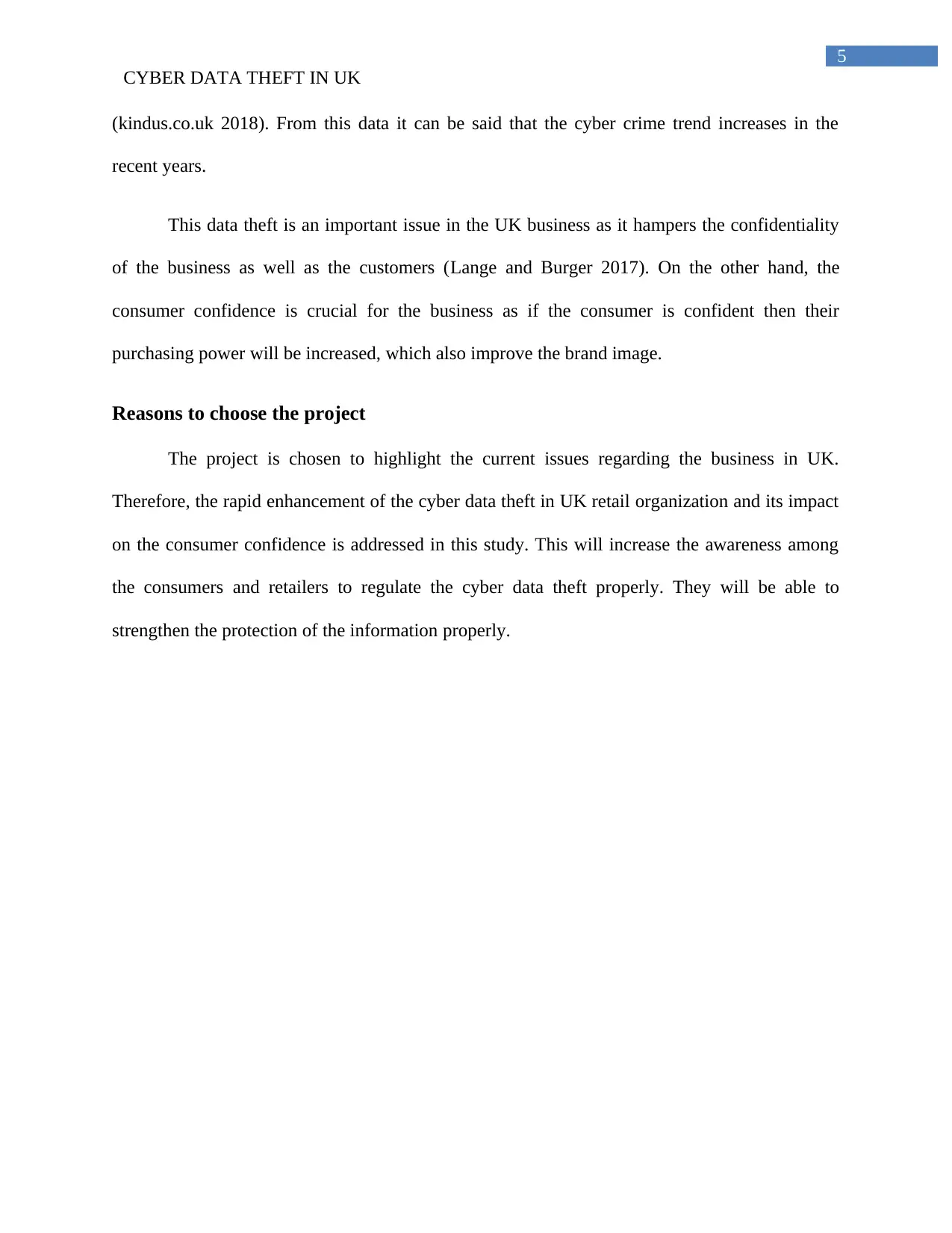
5
CYBER DATA THEFT IN UK
(kindus.co.uk 2018). From this data it can be said that the cyber crime trend increases in the
recent years.
This data theft is an important issue in the UK business as it hampers the confidentiality
of the business as well as the customers (Lange and Burger 2017). On the other hand, the
consumer confidence is crucial for the business as if the consumer is confident then their
purchasing power will be increased, which also improve the brand image.
Reasons to choose the project
The project is chosen to highlight the current issues regarding the business in UK.
Therefore, the rapid enhancement of the cyber data theft in UK retail organization and its impact
on the consumer confidence is addressed in this study. This will increase the awareness among
the consumers and retailers to regulate the cyber data theft properly. They will be able to
strengthen the protection of the information properly.
CYBER DATA THEFT IN UK
(kindus.co.uk 2018). From this data it can be said that the cyber crime trend increases in the
recent years.
This data theft is an important issue in the UK business as it hampers the confidentiality
of the business as well as the customers (Lange and Burger 2017). On the other hand, the
consumer confidence is crucial for the business as if the consumer is confident then their
purchasing power will be increased, which also improve the brand image.
Reasons to choose the project
The project is chosen to highlight the current issues regarding the business in UK.
Therefore, the rapid enhancement of the cyber data theft in UK retail organization and its impact
on the consumer confidence is addressed in this study. This will increase the awareness among
the consumers and retailers to regulate the cyber data theft properly. They will be able to
strengthen the protection of the information properly.
⊘ This is a preview!⊘
Do you want full access?
Subscribe today to unlock all pages.

Trusted by 1+ million students worldwide
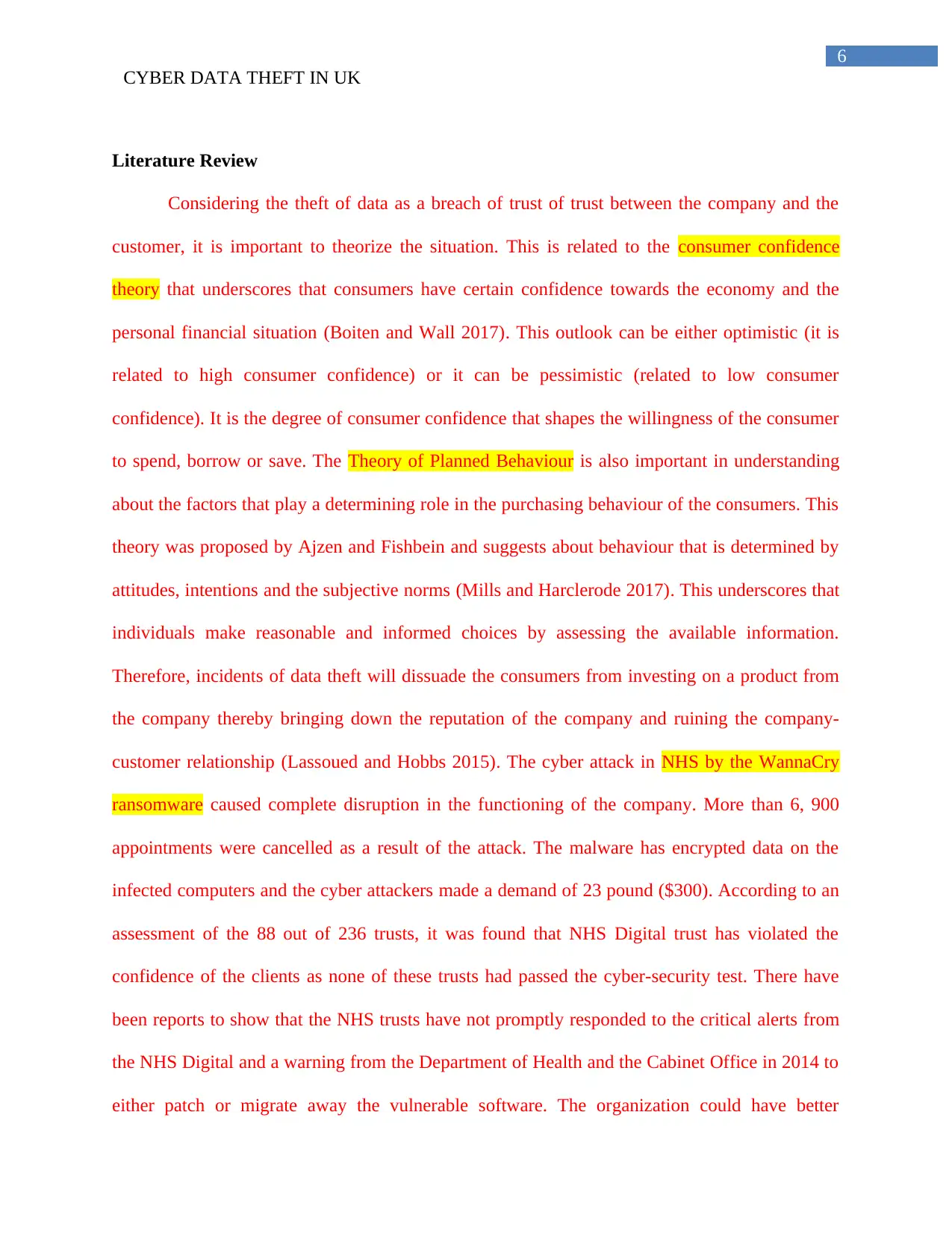
6
CYBER DATA THEFT IN UK
Literature Review
Considering the theft of data as a breach of trust of trust between the company and the
customer, it is important to theorize the situation. This is related to the consumer confidence
theory that underscores that consumers have certain confidence towards the economy and the
personal financial situation (Boiten and Wall 2017). This outlook can be either optimistic (it is
related to high consumer confidence) or it can be pessimistic (related to low consumer
confidence). It is the degree of consumer confidence that shapes the willingness of the consumer
to spend, borrow or save. The Theory of Planned Behaviour is also important in understanding
about the factors that play a determining role in the purchasing behaviour of the consumers. This
theory was proposed by Ajzen and Fishbein and suggests about behaviour that is determined by
attitudes, intentions and the subjective norms (Mills and Harclerode 2017). This underscores that
individuals make reasonable and informed choices by assessing the available information.
Therefore, incidents of data theft will dissuade the consumers from investing on a product from
the company thereby bringing down the reputation of the company and ruining the company-
customer relationship (Lassoued and Hobbs 2015). The cyber attack in NHS by the WannaCry
ransomware caused complete disruption in the functioning of the company. More than 6, 900
appointments were cancelled as a result of the attack. The malware has encrypted data on the
infected computers and the cyber attackers made a demand of 23 pound ($300). According to an
assessment of the 88 out of 236 trusts, it was found that NHS Digital trust has violated the
confidence of the clients as none of these trusts had passed the cyber-security test. There have
been reports to show that the NHS trusts have not promptly responded to the critical alerts from
the NHS Digital and a warning from the Department of Health and the Cabinet Office in 2014 to
either patch or migrate away the vulnerable software. The organization could have better
CYBER DATA THEFT IN UK
Literature Review
Considering the theft of data as a breach of trust of trust between the company and the
customer, it is important to theorize the situation. This is related to the consumer confidence
theory that underscores that consumers have certain confidence towards the economy and the
personal financial situation (Boiten and Wall 2017). This outlook can be either optimistic (it is
related to high consumer confidence) or it can be pessimistic (related to low consumer
confidence). It is the degree of consumer confidence that shapes the willingness of the consumer
to spend, borrow or save. The Theory of Planned Behaviour is also important in understanding
about the factors that play a determining role in the purchasing behaviour of the consumers. This
theory was proposed by Ajzen and Fishbein and suggests about behaviour that is determined by
attitudes, intentions and the subjective norms (Mills and Harclerode 2017). This underscores that
individuals make reasonable and informed choices by assessing the available information.
Therefore, incidents of data theft will dissuade the consumers from investing on a product from
the company thereby bringing down the reputation of the company and ruining the company-
customer relationship (Lassoued and Hobbs 2015). The cyber attack in NHS by the WannaCry
ransomware caused complete disruption in the functioning of the company. More than 6, 900
appointments were cancelled as a result of the attack. The malware has encrypted data on the
infected computers and the cyber attackers made a demand of 23 pound ($300). According to an
assessment of the 88 out of 236 trusts, it was found that NHS Digital trust has violated the
confidence of the clients as none of these trusts had passed the cyber-security test. There have
been reports to show that the NHS trusts have not promptly responded to the critical alerts from
the NHS Digital and a warning from the Department of Health and the Cabinet Office in 2014 to
either patch or migrate away the vulnerable software. The organization could have better
Paraphrase This Document
Need a fresh take? Get an instant paraphrase of this document with our AI Paraphraser
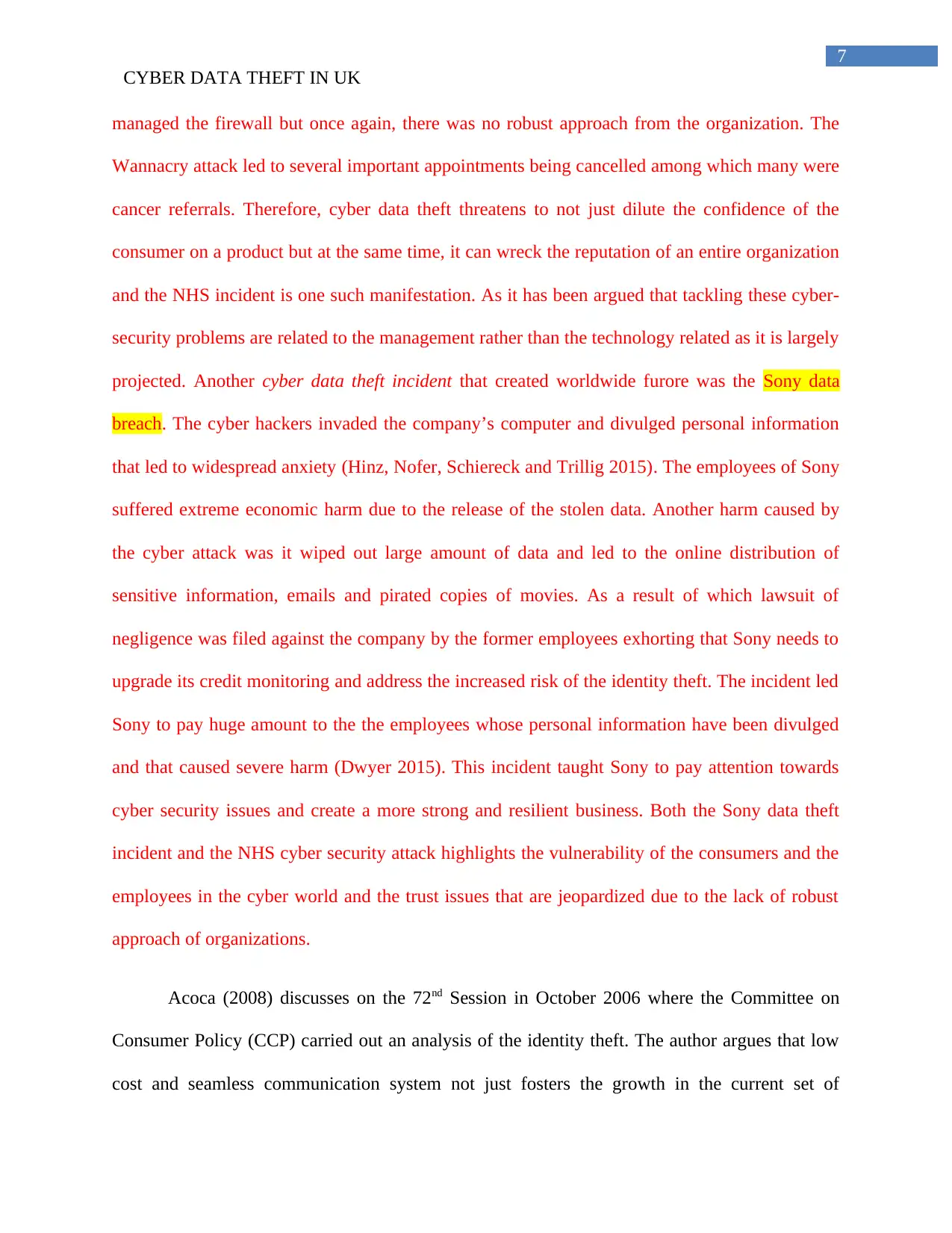
7
CYBER DATA THEFT IN UK
managed the firewall but once again, there was no robust approach from the organization. The
Wannacry attack led to several important appointments being cancelled among which many were
cancer referrals. Therefore, cyber data theft threatens to not just dilute the confidence of the
consumer on a product but at the same time, it can wreck the reputation of an entire organization
and the NHS incident is one such manifestation. As it has been argued that tackling these cyber-
security problems are related to the management rather than the technology related as it is largely
projected. Another cyber data theft incident that created worldwide furore was the Sony data
breach. The cyber hackers invaded the company’s computer and divulged personal information
that led to widespread anxiety (Hinz, Nofer, Schiereck and Trillig 2015). The employees of Sony
suffered extreme economic harm due to the release of the stolen data. Another harm caused by
the cyber attack was it wiped out large amount of data and led to the online distribution of
sensitive information, emails and pirated copies of movies. As a result of which lawsuit of
negligence was filed against the company by the former employees exhorting that Sony needs to
upgrade its credit monitoring and address the increased risk of the identity theft. The incident led
Sony to pay huge amount to the the employees whose personal information have been divulged
and that caused severe harm (Dwyer 2015). This incident taught Sony to pay attention towards
cyber security issues and create a more strong and resilient business. Both the Sony data theft
incident and the NHS cyber security attack highlights the vulnerability of the consumers and the
employees in the cyber world and the trust issues that are jeopardized due to the lack of robust
approach of organizations.
Acoca (2008) discusses on the 72nd Session in October 2006 where the Committee on
Consumer Policy (CCP) carried out an analysis of the identity theft. The author argues that low
cost and seamless communication system not just fosters the growth in the current set of
CYBER DATA THEFT IN UK
managed the firewall but once again, there was no robust approach from the organization. The
Wannacry attack led to several important appointments being cancelled among which many were
cancer referrals. Therefore, cyber data theft threatens to not just dilute the confidence of the
consumer on a product but at the same time, it can wreck the reputation of an entire organization
and the NHS incident is one such manifestation. As it has been argued that tackling these cyber-
security problems are related to the management rather than the technology related as it is largely
projected. Another cyber data theft incident that created worldwide furore was the Sony data
breach. The cyber hackers invaded the company’s computer and divulged personal information
that led to widespread anxiety (Hinz, Nofer, Schiereck and Trillig 2015). The employees of Sony
suffered extreme economic harm due to the release of the stolen data. Another harm caused by
the cyber attack was it wiped out large amount of data and led to the online distribution of
sensitive information, emails and pirated copies of movies. As a result of which lawsuit of
negligence was filed against the company by the former employees exhorting that Sony needs to
upgrade its credit monitoring and address the increased risk of the identity theft. The incident led
Sony to pay huge amount to the the employees whose personal information have been divulged
and that caused severe harm (Dwyer 2015). This incident taught Sony to pay attention towards
cyber security issues and create a more strong and resilient business. Both the Sony data theft
incident and the NHS cyber security attack highlights the vulnerability of the consumers and the
employees in the cyber world and the trust issues that are jeopardized due to the lack of robust
approach of organizations.
Acoca (2008) discusses on the 72nd Session in October 2006 where the Committee on
Consumer Policy (CCP) carried out an analysis of the identity theft. The author argues that low
cost and seamless communication system not just fosters the growth in the current set of
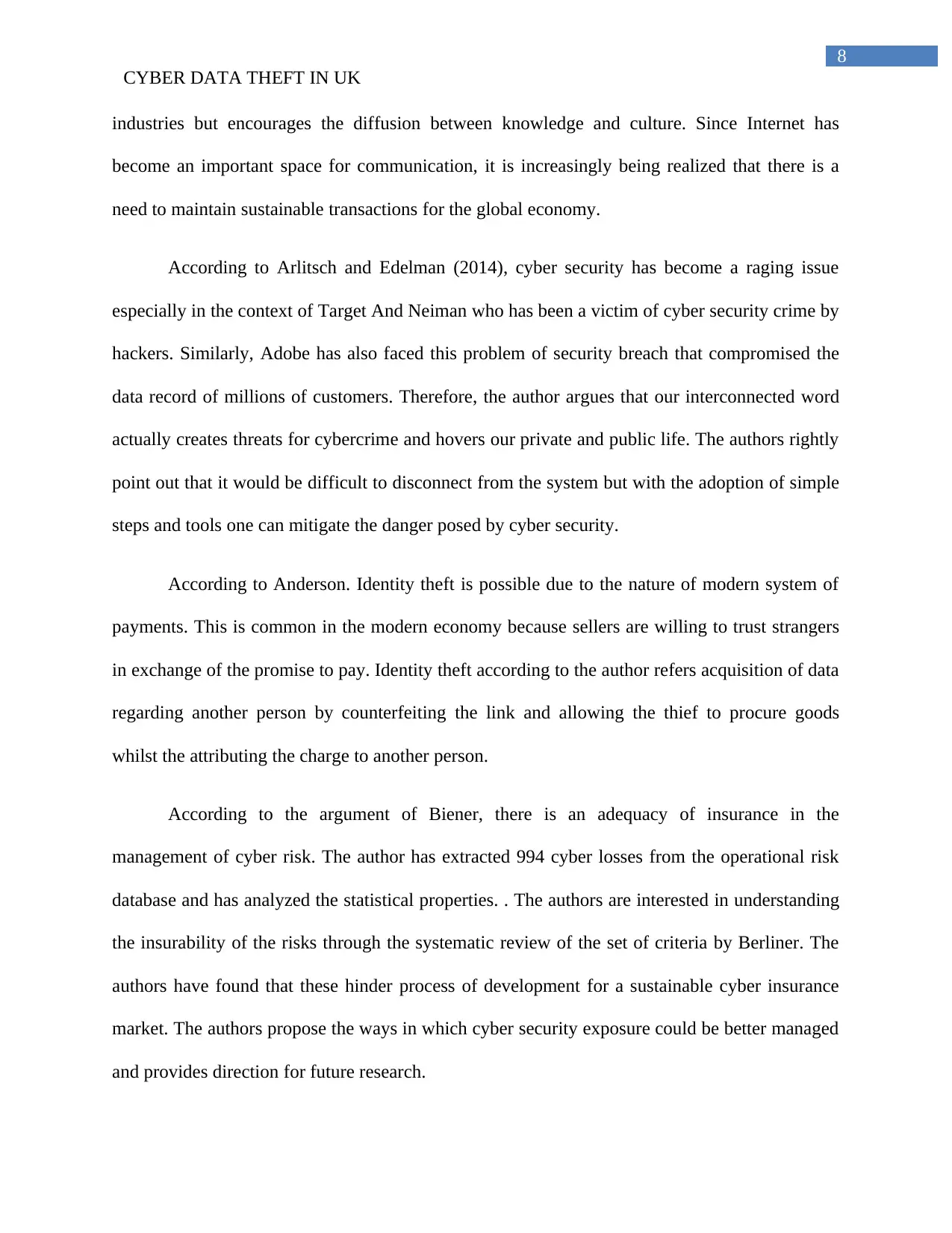
8
CYBER DATA THEFT IN UK
industries but encourages the diffusion between knowledge and culture. Since Internet has
become an important space for communication, it is increasingly being realized that there is a
need to maintain sustainable transactions for the global economy.
According to Arlitsch and Edelman (2014), cyber security has become a raging issue
especially in the context of Target And Neiman who has been a victim of cyber security crime by
hackers. Similarly, Adobe has also faced this problem of security breach that compromised the
data record of millions of customers. Therefore, the author argues that our interconnected word
actually creates threats for cybercrime and hovers our private and public life. The authors rightly
point out that it would be difficult to disconnect from the system but with the adoption of simple
steps and tools one can mitigate the danger posed by cyber security.
According to Anderson. Identity theft is possible due to the nature of modern system of
payments. This is common in the modern economy because sellers are willing to trust strangers
in exchange of the promise to pay. Identity theft according to the author refers acquisition of data
regarding another person by counterfeiting the link and allowing the thief to procure goods
whilst the attributing the charge to another person.
According to the argument of Biener, there is an adequacy of insurance in the
management of cyber risk. The author has extracted 994 cyber losses from the operational risk
database and has analyzed the statistical properties. . The authors are interested in understanding
the insurability of the risks through the systematic review of the set of criteria by Berliner. The
authors have found that these hinder process of development for a sustainable cyber insurance
market. The authors propose the ways in which cyber security exposure could be better managed
and provides direction for future research.
CYBER DATA THEFT IN UK
industries but encourages the diffusion between knowledge and culture. Since Internet has
become an important space for communication, it is increasingly being realized that there is a
need to maintain sustainable transactions for the global economy.
According to Arlitsch and Edelman (2014), cyber security has become a raging issue
especially in the context of Target And Neiman who has been a victim of cyber security crime by
hackers. Similarly, Adobe has also faced this problem of security breach that compromised the
data record of millions of customers. Therefore, the author argues that our interconnected word
actually creates threats for cybercrime and hovers our private and public life. The authors rightly
point out that it would be difficult to disconnect from the system but with the adoption of simple
steps and tools one can mitigate the danger posed by cyber security.
According to Anderson. Identity theft is possible due to the nature of modern system of
payments. This is common in the modern economy because sellers are willing to trust strangers
in exchange of the promise to pay. Identity theft according to the author refers acquisition of data
regarding another person by counterfeiting the link and allowing the thief to procure goods
whilst the attributing the charge to another person.
According to the argument of Biener, there is an adequacy of insurance in the
management of cyber risk. The author has extracted 994 cyber losses from the operational risk
database and has analyzed the statistical properties. . The authors are interested in understanding
the insurability of the risks through the systematic review of the set of criteria by Berliner. The
authors have found that these hinder process of development for a sustainable cyber insurance
market. The authors propose the ways in which cyber security exposure could be better managed
and provides direction for future research.
⊘ This is a preview!⊘
Do you want full access?
Subscribe today to unlock all pages.

Trusted by 1+ million students worldwide
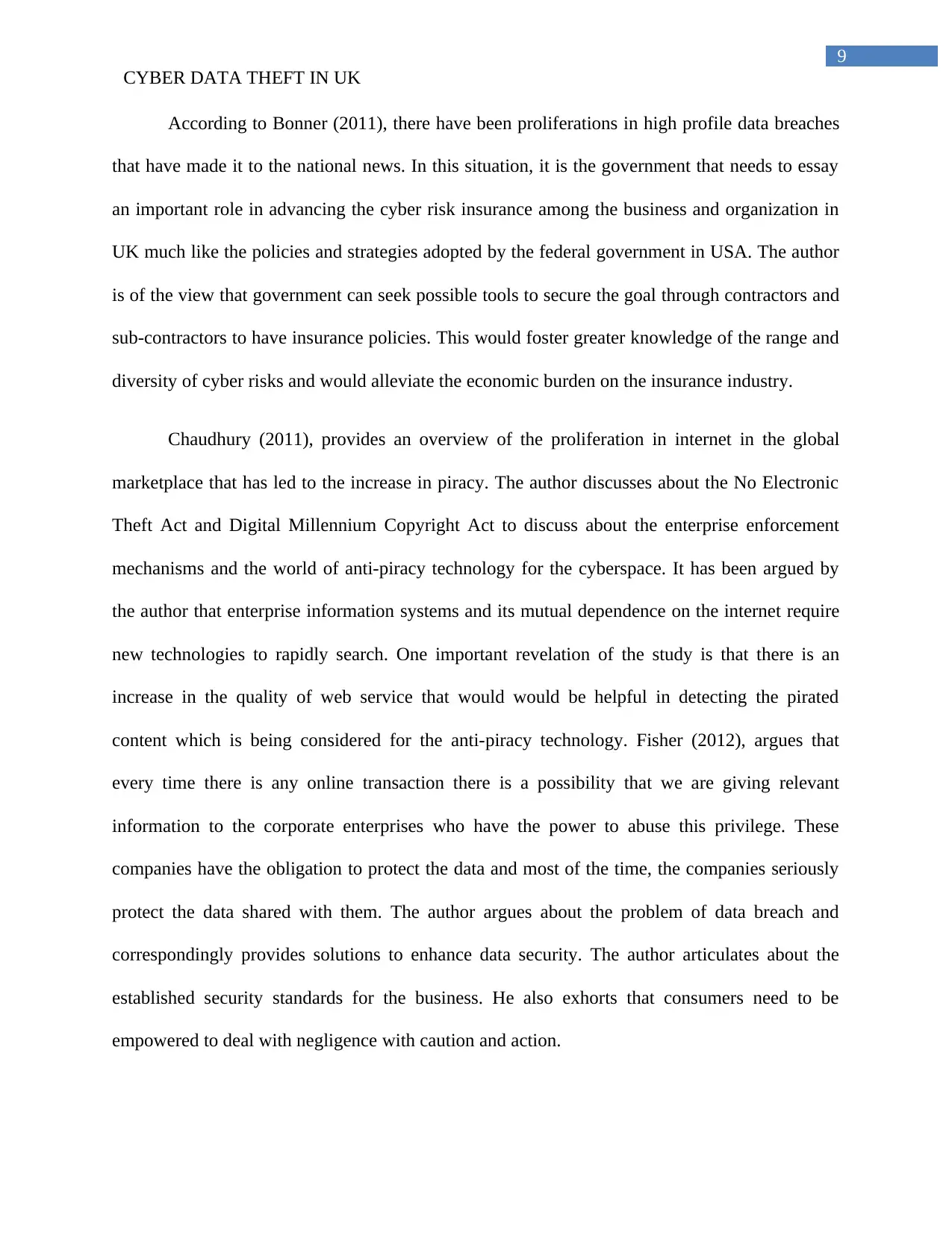
9
CYBER DATA THEFT IN UK
According to Bonner (2011), there have been proliferations in high profile data breaches
that have made it to the national news. In this situation, it is the government that needs to essay
an important role in advancing the cyber risk insurance among the business and organization in
UK much like the policies and strategies adopted by the federal government in USA. The author
is of the view that government can seek possible tools to secure the goal through contractors and
sub-contractors to have insurance policies. This would foster greater knowledge of the range and
diversity of cyber risks and would alleviate the economic burden on the insurance industry.
Chaudhury (2011), provides an overview of the proliferation in internet in the global
marketplace that has led to the increase in piracy. The author discusses about the No Electronic
Theft Act and Digital Millennium Copyright Act to discuss about the enterprise enforcement
mechanisms and the world of anti-piracy technology for the cyberspace. It has been argued by
the author that enterprise information systems and its mutual dependence on the internet require
new technologies to rapidly search. One important revelation of the study is that there is an
increase in the quality of web service that would would be helpful in detecting the pirated
content which is being considered for the anti-piracy technology. Fisher (2012), argues that
every time there is any online transaction there is a possibility that we are giving relevant
information to the corporate enterprises who have the power to abuse this privilege. These
companies have the obligation to protect the data and most of the time, the companies seriously
protect the data shared with them. The author argues about the problem of data breach and
correspondingly provides solutions to enhance data security. The author articulates about the
established security standards for the business. He also exhorts that consumers need to be
empowered to deal with negligence with caution and action.
CYBER DATA THEFT IN UK
According to Bonner (2011), there have been proliferations in high profile data breaches
that have made it to the national news. In this situation, it is the government that needs to essay
an important role in advancing the cyber risk insurance among the business and organization in
UK much like the policies and strategies adopted by the federal government in USA. The author
is of the view that government can seek possible tools to secure the goal through contractors and
sub-contractors to have insurance policies. This would foster greater knowledge of the range and
diversity of cyber risks and would alleviate the economic burden on the insurance industry.
Chaudhury (2011), provides an overview of the proliferation in internet in the global
marketplace that has led to the increase in piracy. The author discusses about the No Electronic
Theft Act and Digital Millennium Copyright Act to discuss about the enterprise enforcement
mechanisms and the world of anti-piracy technology for the cyberspace. It has been argued by
the author that enterprise information systems and its mutual dependence on the internet require
new technologies to rapidly search. One important revelation of the study is that there is an
increase in the quality of web service that would would be helpful in detecting the pirated
content which is being considered for the anti-piracy technology. Fisher (2012), argues that
every time there is any online transaction there is a possibility that we are giving relevant
information to the corporate enterprises who have the power to abuse this privilege. These
companies have the obligation to protect the data and most of the time, the companies seriously
protect the data shared with them. The author argues about the problem of data breach and
correspondingly provides solutions to enhance data security. The author articulates about the
established security standards for the business. He also exhorts that consumers need to be
empowered to deal with negligence with caution and action.
Paraphrase This Document
Need a fresh take? Get an instant paraphrase of this document with our AI Paraphraser
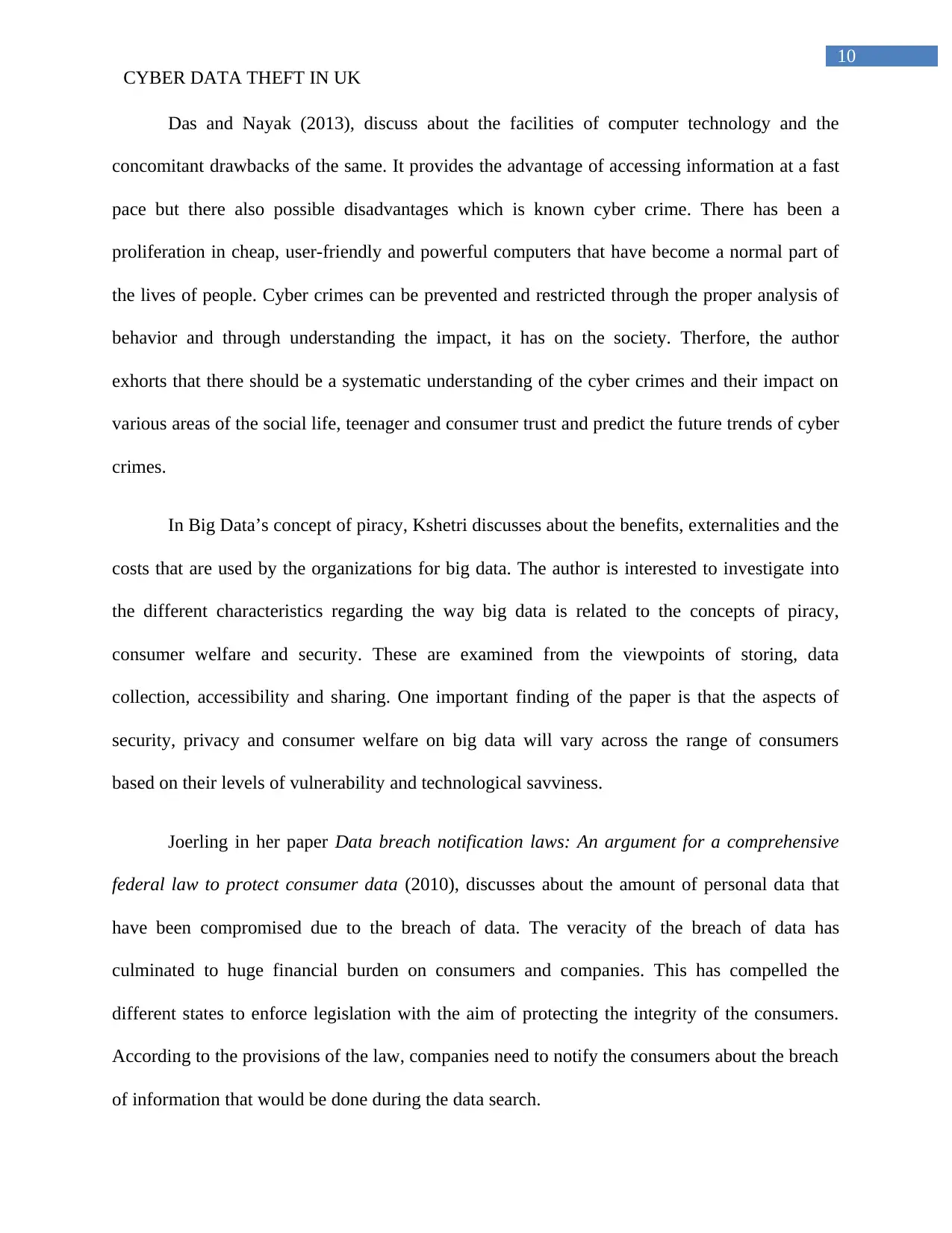
10
CYBER DATA THEFT IN UK
Das and Nayak (2013), discuss about the facilities of computer technology and the
concomitant drawbacks of the same. It provides the advantage of accessing information at a fast
pace but there also possible disadvantages which is known cyber crime. There has been a
proliferation in cheap, user-friendly and powerful computers that have become a normal part of
the lives of people. Cyber crimes can be prevented and restricted through the proper analysis of
behavior and through understanding the impact, it has on the society. Therfore, the author
exhorts that there should be a systematic understanding of the cyber crimes and their impact on
various areas of the social life, teenager and consumer trust and predict the future trends of cyber
crimes.
In Big Data’s concept of piracy, Kshetri discusses about the benefits, externalities and the
costs that are used by the organizations for big data. The author is interested to investigate into
the different characteristics regarding the way big data is related to the concepts of piracy,
consumer welfare and security. These are examined from the viewpoints of storing, data
collection, accessibility and sharing. One important finding of the paper is that the aspects of
security, privacy and consumer welfare on big data will vary across the range of consumers
based on their levels of vulnerability and technological savviness.
Joerling in her paper Data breach notification laws: An argument for a comprehensive
federal law to protect consumer data (2010), discusses about the amount of personal data that
have been compromised due to the breach of data. The veracity of the breach of data has
culminated to huge financial burden on consumers and companies. This has compelled the
different states to enforce legislation with the aim of protecting the integrity of the consumers.
According to the provisions of the law, companies need to notify the consumers about the breach
of information that would be done during the data search.
CYBER DATA THEFT IN UK
Das and Nayak (2013), discuss about the facilities of computer technology and the
concomitant drawbacks of the same. It provides the advantage of accessing information at a fast
pace but there also possible disadvantages which is known cyber crime. There has been a
proliferation in cheap, user-friendly and powerful computers that have become a normal part of
the lives of people. Cyber crimes can be prevented and restricted through the proper analysis of
behavior and through understanding the impact, it has on the society. Therfore, the author
exhorts that there should be a systematic understanding of the cyber crimes and their impact on
various areas of the social life, teenager and consumer trust and predict the future trends of cyber
crimes.
In Big Data’s concept of piracy, Kshetri discusses about the benefits, externalities and the
costs that are used by the organizations for big data. The author is interested to investigate into
the different characteristics regarding the way big data is related to the concepts of piracy,
consumer welfare and security. These are examined from the viewpoints of storing, data
collection, accessibility and sharing. One important finding of the paper is that the aspects of
security, privacy and consumer welfare on big data will vary across the range of consumers
based on their levels of vulnerability and technological savviness.
Joerling in her paper Data breach notification laws: An argument for a comprehensive
federal law to protect consumer data (2010), discusses about the amount of personal data that
have been compromised due to the breach of data. The veracity of the breach of data has
culminated to huge financial burden on consumers and companies. This has compelled the
different states to enforce legislation with the aim of protecting the integrity of the consumers.
According to the provisions of the law, companies need to notify the consumers about the breach
of information that would be done during the data search.
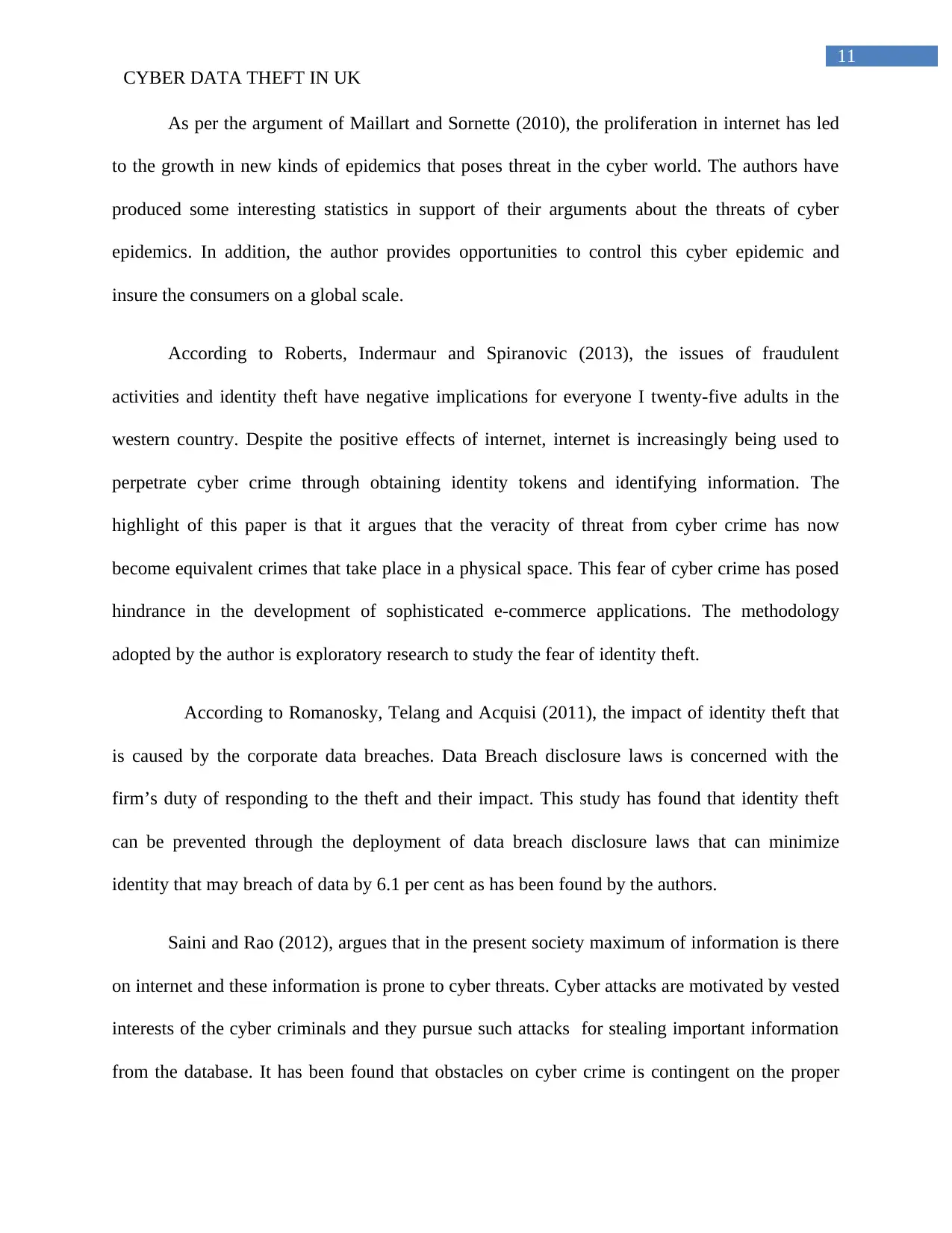
11
CYBER DATA THEFT IN UK
As per the argument of Maillart and Sornette (2010), the proliferation in internet has led
to the growth in new kinds of epidemics that poses threat in the cyber world. The authors have
produced some interesting statistics in support of their arguments about the threats of cyber
epidemics. In addition, the author provides opportunities to control this cyber epidemic and
insure the consumers on a global scale.
According to Roberts, Indermaur and Spiranovic (2013), the issues of fraudulent
activities and identity theft have negative implications for everyone I twenty-five adults in the
western country. Despite the positive effects of internet, internet is increasingly being used to
perpetrate cyber crime through obtaining identity tokens and identifying information. The
highlight of this paper is that it argues that the veracity of threat from cyber crime has now
become equivalent crimes that take place in a physical space. This fear of cyber crime has posed
hindrance in the development of sophisticated e-commerce applications. The methodology
adopted by the author is exploratory research to study the fear of identity theft.
According to Romanosky, Telang and Acquisi (2011), the impact of identity theft that
is caused by the corporate data breaches. Data Breach disclosure laws is concerned with the
firm’s duty of responding to the theft and their impact. This study has found that identity theft
can be prevented through the deployment of data breach disclosure laws that can minimize
identity that may breach of data by 6.1 per cent as has been found by the authors.
Saini and Rao (2012), argues that in the present society maximum of information is there
on internet and these information is prone to cyber threats. Cyber attacks are motivated by vested
interests of the cyber criminals and they pursue such attacks for stealing important information
from the database. It has been found that obstacles on cyber crime is contingent on the proper
CYBER DATA THEFT IN UK
As per the argument of Maillart and Sornette (2010), the proliferation in internet has led
to the growth in new kinds of epidemics that poses threat in the cyber world. The authors have
produced some interesting statistics in support of their arguments about the threats of cyber
epidemics. In addition, the author provides opportunities to control this cyber epidemic and
insure the consumers on a global scale.
According to Roberts, Indermaur and Spiranovic (2013), the issues of fraudulent
activities and identity theft have negative implications for everyone I twenty-five adults in the
western country. Despite the positive effects of internet, internet is increasingly being used to
perpetrate cyber crime through obtaining identity tokens and identifying information. The
highlight of this paper is that it argues that the veracity of threat from cyber crime has now
become equivalent crimes that take place in a physical space. This fear of cyber crime has posed
hindrance in the development of sophisticated e-commerce applications. The methodology
adopted by the author is exploratory research to study the fear of identity theft.
According to Romanosky, Telang and Acquisi (2011), the impact of identity theft that
is caused by the corporate data breaches. Data Breach disclosure laws is concerned with the
firm’s duty of responding to the theft and their impact. This study has found that identity theft
can be prevented through the deployment of data breach disclosure laws that can minimize
identity that may breach of data by 6.1 per cent as has been found by the authors.
Saini and Rao (2012), argues that in the present society maximum of information is there
on internet and these information is prone to cyber threats. Cyber attacks are motivated by vested
interests of the cyber criminals and they pursue such attacks for stealing important information
from the database. It has been found that obstacles on cyber crime is contingent on the proper
⊘ This is a preview!⊘
Do you want full access?
Subscribe today to unlock all pages.

Trusted by 1+ million students worldwide
1 out of 41
Related Documents
Your All-in-One AI-Powered Toolkit for Academic Success.
+13062052269
info@desklib.com
Available 24*7 on WhatsApp / Email
![[object Object]](/_next/static/media/star-bottom.7253800d.svg)
Unlock your academic potential
Copyright © 2020–2025 A2Z Services. All Rights Reserved. Developed and managed by ZUCOL.





